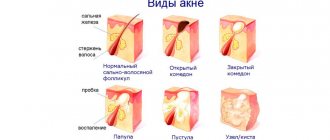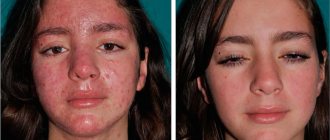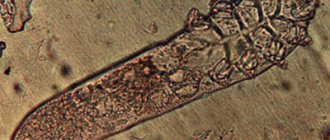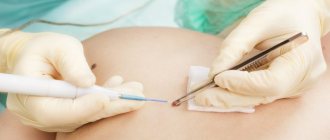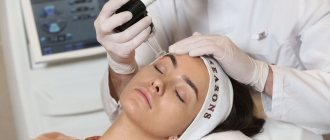Published: 11/01/2021 15:25:00 Updated: 11/01/2021
Acne is a chronic inflammatory skin disease caused by excessive sebum production and blockage of the sebaceous gland ducts. As a result of the accumulation of secretions, blackheads characteristic of acne appear.
In adolescents, acne is considered the most common skin disease, and in general it affects more than 65% of the population. Most often, the disease is observed on the skin of the face, representing not only a medical, but also a cosmetic problem.
Acne is not an independent disease, but a symptom of one or more disorders in the body. Without timely and appropriate treatment, severe skin lesions develop, which require complex therapy lasting several months and even years, as well as cosmetic procedures to eliminate cosmetic defects.
Causes of acne
The following main causes of the problem are known:
- hormonal disorders (adolescence, pregnancy, menstrual cycle phase, excess cortisol due to chronic stress);
- diseases of the gastrointestinal tract and thyroid gland;
- improper skin care or incorrectly selected cosmetics;
- taking certain medications (for example, anabolic steroids);
- genetic predisposition;
- skin damage accompanied by local inflammation;
- anatomical features of the skin (thickening of the stratum corneum, accumulation of epidermal particles in the pores, intensive proliferation of bacteria that cause inflammation);
- unhealthy diet and bad habits.
In infants, acne occurs in the first months of life due to excess levels of maternal hormones in the blood, which are transmitted in the last trimester of pregnancy or enter the baby's body during breastfeeding (stress hormone cortisol). Another common cause is considered to be dysfunction of the sebaceous glands during the formation of the baby’s hormonal levels.
How to treat acne vulgaris and which specialists should you be examined by?
In the presence of acne vulgaris*, treatment may be beyond the competence of a dermatologist if the causes of the disease are related to the malfunction of other organs and systems. A dermatologist may recommend consultations with the following specialists31:
- Gynecologist. Acne on the face of women after 30 may indicate polycystic disease, especially in the presence of anovulatory menstrual cycles and hirsutism.
- Endocrinologist. Pituitary adenoma and adrenal hyperplasia can be blamed for the appearance of acne. The endocrinologist checks the patient for the presence of thyroid pathologies and excludes carbohydrate metabolism disorders. If you have acne that is resistant to treatment, it makes sense to check for androgen-producing tumors. In women, for example, tumors of the ovaries and adrenal gland are excluded.
- Gastroenterologist. If acne is combined with rosacea (especially in men), you need to pay attention to the study of the gastrointestinal tract.
- Psychiatrist. Acnephobia is a real mental disorder in which a person scratches an existing or imaginary rash, injuring the skin and causing acne to worsen. Observation by a psychiatrist should take place in parallel with the main treatment of acne.
Acne classification
There are several characteristic disorders of acne:
- Comedones: plugs that form in the pores and consist of sebum and epithelial cells. Open comedones form blackheads, and closed comedones form whiteheads.
- Papules: dense pimples without a purulent head, which are usually formed from closed comedones. When formed from a closed comedon, the opening of the hair follicle is noticeably expanded in the form of a dark plug.
- Pustules: pimple with purulent contents.
- Nodules and cysts: subcutaneous lumps filled with pus. Usually bluish-purple in color. They leave deep scars.
According to the severity, there are 4 degrees of the disease according to the classification of the American Academy of Dermatology:
- mild: comedones and single papules;
- moderate: multiple papules, single pustules;
- severe: multiple papules and pustules, single nodes;
- extremely severe: multiple nodes and cysts.
Newborn acne appears as tiny red bumps on the face or upper chest and back.
How is a clinical examination performed?
Clinical examination of patients with acne includes an examination during which the doctor examines the condition of the skin, the number of acne lesions on the face and body.
The nature of the examination depends on many factors31:
- age;
- gender;
- family history (examined for evidence of acne history by parents);
- gynecological history (in women);
- duration of acne;
- severity of the disease;
- the effectiveness of previously prescribed therapy;
- general condition of the patient;
- combinations of acne vulgaris* with other dermatoses, etc.
The specialist performs palpation, pressing on the acne elements with a special tool (glass or cotton swab). This allows him to assess the density of formations, the presence of skin pain during touch, and study the fluid released when pressure is applied. In addition, the dermatologist examines the presence of scars.
Diagnosis of acne
The primary diagnosis is made after examining the patient by a dermatologist.
In appearance, acne-prone skin has a characteristic greasy sheen, enlarged pores, spots and various rashes. Problem areas for acne are usually the T-zone of the face (chin, nose and forehead), as well as the shoulders, upper back and chest, and less often the scalp. Since the causes of the problem are individual, patients are recommended to undergo a comprehensive examination, which includes a blood test (hormone levels: free testosterone, dehydroepiandrosterone sulfate, luteinizing hormone, follicle-stimulating hormone; glucose tolerance test) and consultation with other specialists to identify the underlying disease that caused acne (gastroenterologist, endocrinologist, gynecologist).
A genetic test is also performed to determine your predisposition to acne and a skin swab is taken to determine sensitivity to antibiotics.
Differential diagnosis is carried out to exclude other skin diseases (rosacea, secondary syphilis, perioral dermatitis).
What is LHE technology?
When talking about LHE, we are talking about exposure to broadband pulsed light. LHE therapy uses a special lamp containing inert gases, which allows you to work with light ranges of 600-900 nm (from green to IR). The green and yellow spectrum are able to reach the sebaceous gland; during the procedure, they are absorbed by the chromophore porphyrin.
During this chemical reaction, atomic oxygen is released, which causes peroxidation of the bacterial walls. IR radiation has an anti-inflammatory effect, helps pores open, improves microcirculation, and activates phagocytosis.
The course of LHE therapy lasts 1-2 months. As a rule, patients are prescribed 2 sessions per week, each lasting 20-30 minutes. The procedure does not require rehabilitation, so patients can not be interrupted from their daily activities.
Acne treatment
Since dysfunction of the sebaceous glands at an early age is observed in the vast majority of people, serious treatment is usually not carried out until the age of 25 and is limited to regular visits to a dermatologist (monitoring the condition) and a cosmetologist (facial cleansing, peelings, skincare procedures).
If the problem persists or becomes serious, then complex therapy is selected for the patient. It is aimed at eliminating inflammation; reducing the number of bacteria on the surface of problem areas of the skin, reducing the formation of sebum and reducing the influence of hormones on the functioning of the sebaceous glands.
Drug treatment of acne can be local (creams, gels, ointments based on azelaic acid, benzoyl peroxide and other antibacterial drugs), as well as systemic, when drugs are prescribed for oral administration (antibiotics, hormonal drugs, drugs to combat the underlying disease). Usually these two approaches are combined. In addition, the specialist will select the optimal skin care using cosmetics.
Parents are concerned about how to get rid of acne in babies. As a rule, only regular and competent care is required for the baby’s skin; all rashes go away on their own and without consequences.
Particular attention should be paid to the diet for acne. If the problem is related to disorders in the gastrointestinal tract, the gastroenterologist will give appropriate nutritional recommendations. The general principles of diet therapy for skin problems require excluding from the diet sweets, flour and bakery products, fast food, alcoholic and carbonated drinks, coffee and strong tea, spices and sauces, fatty foods (smoked meats, fatty fish and meats), milk. Preference should be given to foods rich in vitamins C, A, E and B vitamins, antioxidants, selenium and zinc, omega acids, fiber (raw vegetables and fruits, nuts). Separately, we can highlight compliance with the drinking regime: water accelerates the elimination of toxins and wastes, which in acne slow down recovery or cause deterioration.
Acne-prone skin: care
Sensitive skin may react by developing acne if not properly cared for. Therefore, it is worth excluding products with fragrances, mineral oils, and alcohol (ethyl, ethanol, etc.) from your daily beauty routine. These ingredients can disrupt pH and harm the hydrolipid mantle.
Avoid perfumed cosmetics; they may contain phthalates as fragrances, which can affect hormonal levels. Vaseline and liquid paraffin can clog pores, causing acne.
If you develop rashes as a result of improper care or other reasons, you need to get rid of them correctly. One of the topical remedies against acne is Azelik® gel, which must be applied 2 times a day to cleansed skin5.
Useful ingredients for rashes include vitamin A, tea tree oil, lactic, salicylic, azelaic, glycolic acids, clay, sulfur.
Care for dry skin with acne
Acne usually appears on oily skin, but dry skin is not immune to inflammation. Constantly flaky and dehydrated epidermis is vulnerable to bacterial attack. You should not frequently use exfoliating agents, as they can damage the hydrolipidic mantle, destroying the protection against pathogenic microflora.
It is better to replace foamy cleansers with creamy ones. You can apply salicylic acid cream at night.
Care for oily, acne-prone skin
Oily skin with acne needs more thorough cleansing. Your care should include products with charcoal, salicylic acid, and tea tree oil. After washing your face, you can use clay masks once a week.
Don't neglect hydration. Maintaining the moisture balance of oily skin is extremely important. With a lack of moisture, the sebaceous glands will produce more secretion, which will worsen the course of acne.
Consequences of acne and their elimination
Post-acne is a general name for cosmetic skin defects at the site of former foci of inflammation: scars, cicatrices, bumps, depressions, hyperpigmentation. Methods for eliminating these shortcomings are divided into:
- surgical: excision or laser destruction of scar tissue. Used for the formation of serious scars;
- non-surgical: pharmacological therapy (chemical peels with salicylic, lactic, trichloroacetic or azelaic acids), hardware treatment methods (laser resurfacing), injection treatment methods (plasma lifting, needling, mesotherapy, scar filling with preparations based on hyaluronic acid or collagen).
Acne pimples are not just a minor drawback, but a possible sign of a serious problem with serious consequences, so self-medication is unacceptable.
A timely visit to a specialist will help maintain healthy facial skin and prevent consequences, protect the patient from psychological trauma and improve his quality of life. Author:
Pugonina Tatyana Alekseevna, Therapist
Treatment of acne* due to hormonal imbalance
Treatment of acne* due to hormonal imbalance is aimed at normalizing androgen levels, including through pathogenetic therapy of the underlying disease. It is necessary to use drugs with an antiandrogenic effect that will slow down the production of androgens in the adrenal glands and ovaries, selectively suppress the production of gonadotropic hormones by the pituitary gland, competitively block androgen receptors in the skin, and reduce the conversion of testosterone to DHT in target tissues by suppressing the synthesis of 5-alpha reductase36. Gynecologists can recommend monophasic low-dose medications that contain gestagens with antiandrogenic activity36.
Dermatologists are developing a course of therapy that will affect the pathogenesis of acne. Azelaic acid preparations can be used for acne9. They have the following effects19:
- reduce the synthesis of 5α-reductase, leading to a decrease in the level of dehydrotestosterone in sebocytes, which leads to normalization of the processes of sebum secretion and keratinization;
- have a bactericidal effect against gram-negative and gram-positive microorganisms;
- have an anti-inflammatory effect.
Azelik® – 15% azelaic acid gel. The drug helps normalize keratinization processes, reduce the level of free fatty acids on the skin, fight propionibacteria and epidermal staphylococcus5. The anti-inflammatory effect is due to a decrease in neutrophil metabolism and their production of free radical oxygen species5.
*acne
Effect of the procedure: does LHE help if there are acne on the neck?
Immediately after the session, mild transient erythema may be observed. Rarely, acne may worsen after the first 2-3 sessions. This is due to the destruction of bacteria and the acceleration of the development of morphological elements. During the procedure, patients usually do not experience pain; sometimes a slight burning sensation is possible in the treated area.
You should not expect instant results from using the technique. The effect can be assessed by approximately 3-4 weeks of therapy.
If acne appears on the neck, other area of the body or face, LHE technology will not help as monotherapy. It must be combined with drug treatment prescribed by a doctor.
